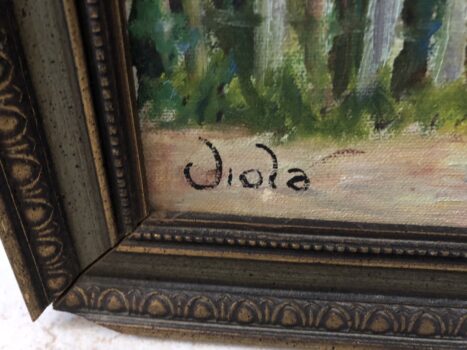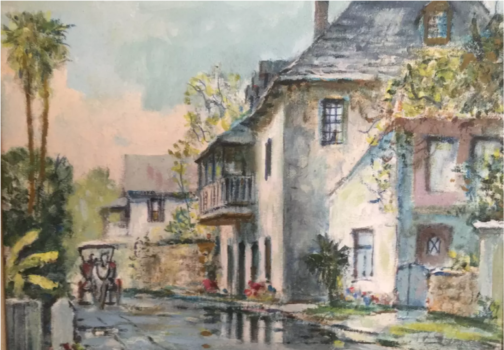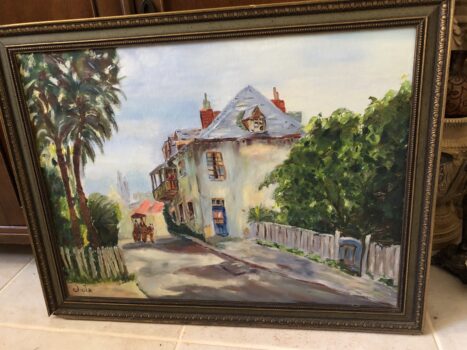This art appraisal report offers an in-depth and impartial assessment of the artwork in question, grounded in the appraiser’s expertise and familiarity with the art market. All the information and data analyzed in this report is sourced solely from the client.
Having a clear understanding of the value of your artwork is crucial in making informed decisions about its future. This report provides a precise estimate of the value of each piece, using US dollars as the base currency. It is not intended to encourage the sale of the artwork, but rather to provide valuable information on how to proceed should the client decide to do so in the future.
Detailed description of the artwork, including its medium, dimensions, and condition.
Checking Originality: Identification with Artificial Intelligence Test
In the quest to identify a match, Image Search employs advanced AI techniques to scour databases of images in order to find visually similar images. This is achieved through the use of various algorithms such as pattern recognition and machine learning. While some results may be considered as “matches” due to a clear similarity, other results may be inconclusive as they rely more on chance rather than any specific similarities. To conduct this test, a front-facing image was used as a reference to search for similar images on the internet.
The results of the automatic recognition are not conclusive. If a match is found, it will be shown below:
What specific information can we obtain from this test?
Our findings demonstrate this is a unique work of art; the comparison images in our gallery could not be matched with it. Even though there is always some uncertainty, we’ve found that this method gives accurate results 90% of the time, so it’s a good way to start figuring out if something is real. To completely identify the artwork, I continue to the next test.
This is an original hand made painting of Aviles Street. This street was a popular place for street artists to paint all kind of street scenes. One of the most famous is Emmett Fritz. This is another example of a similar scene painting by Emmett.
Age estimation
To determine the age of an original artwork attributed to Lorenzo VIOLA (1938) of Aviles Street in the style of Emmett Fritz, there are several characteristics one can examine. Firstly, the frame construction can be examined for clues. For example, the type of wood used to construct the frame and the joinery used can help to date the painting. Additionally, the color palette used can be another clue. Paint colors used in the artwork can help to date it. For instance, the colors used in the painting attributed to Lorenzo VIOLA are indicative of the mid-20th century. In addition, the style of the artwork is also a clue. In this case, the painting is in the style of Emmett Fritz. This style was popularized in the mid-20th century, which further supports the dating of the artwork attributed to Lorenzo VIOLA. Therefore, by examining the frame construction, color palette used, and style of the artwork, one can accurately determine the age of the painting attributed to Lorenzo VIOLA (1938) of Aviles Street in the style of Emmett Fritz.
Based on this information and the pictures provided, I can estimate this painting was made circa late 20th Century.
Condition of the artwork
This artwork, an original attributed to Lorenzo Viola from 1938, is in excellent condition with no need for restoration. There are no appreciable damages, and if any damage is present, it is minimal. The painting, which is in the style of Emmett Fritz, depicts Aviles Street in vivid colors and details. It is a beautiful and rare piece that would be a great addition to any collection.
Artist’s name, biographical information, artwork’s provenance (history of ownership) and exhibition history.
I study and research the signature of artwork to see if it matches any known signatures. At this step, I also inspect the painting’s front and back pictures, to find an artist’s name or other identifying features like stickers that may help me identify who has made this work. If there is any, provenance is also seen as an important variable because it helps figure out who the artist is.

A close picture of the signature is included in this report.
I can read the signature as:
Viola
At this point, I can use the signature and try to find the artist’s name in a database of known-listed artists. Basically, it is a database with information about the names, surnames, origins, and biographies of the most well-known artists.
I found that the artist who painted this artwork is a listed and well known artist, Lorenzo VIOLA (1938). He was a local street artist with little national exposure; he is an American artist of Italian ancestry.
Detailed analysis of the artwork’s style, subject matter, and significance within the artist’s oeuvre and the broader art world.
I can check if the style and type of painting match those of the artist referenced.
This original artwork attributed to Lorenzo VIOLA (1938) of Aviles street is a stunning example of Emmett Fritz's unique style. It features dynamic brush strokes, vivid colors, and a sense of movement in the composition, all of which reflect Fritz's emphasis on capturing a moment in time in a highly expressive way. The painting also shows a strong influence of the Baroque style, with its bold, dramatic lines and shapes, and its intricate details. The painting is truly a masterpiece that pays homage to both modern and traditional painting techniques.
Comparable sales information, including prices realized at recent auctions or private sales of similar works by the artist or in the same medium.
In order to provide an up-to-date estimate of the fair market value of the original artwork attributed to Lorenzo VIOLA (1938) of Aviles Street in the style of Emmett Fritz, I utilized the data collected, including auction prices and other relevant market information. This is crucial as it can be used in various contexts such as insurance, estate planning, and art market analysis in order to ascertain the value of this particular painting. It also offers a valuable insight into how the valuation of this artwork may have changed due to environmental, historical, or economic factors, as these all have the potential to affect the market for the painting.
The auction prices were a significant factor in determining the current market value of the artwork, as they are based on actual transactions between buyers and sellers in the art market. As such, they are a strong indicator of the expected value of the piece in the near future.
By analyzing auction results from the last 6 months, I was able to accurately determine the current fair market value of the artwork. This approach provides a comprehensive view of how the value has changed over time and gives insight into any potential areas of appreciation or depreciation in its price. Additionally, it allows me to adjust my valuation as new auction prices become available.
Conclusion
Investing in art can be a great way to diversify your portfolio. Not only can art provide long-term returns through appreciation, but it can also offer immediate diversification benefits given its low correlation with the stock market. In addition, purchasing a piece of artwork can be a great investment, as it can provide a unique piece of history that can be handed down through generations. Furthermore, it can be a great way to add to the aesthetic of a home or office, while also providing a great conversation starter. Art can also be a great source of pride and enjoyment, as the owner of the piece will be the only one to have the work.
This painting can be considered valuable by the art market due to its attribution to Lorenzo VILA and its distinct style, which is in the style of Emmett Fritz. This painting is an original artwork, as opposed to a reproduction, and it is an example of a style of painting that is highly sought after. Additionally, Lorenzo VILA is a well-known artist who is highly respected in the art world and his works are often sought after. Furthermore, the painting itself is of a street in Aviles, which is an area of Spain that is known for its vibrant culture and colorful architecture, which adds to the painting's unique cultural value.
Final Appraisal Value ($)
700-800$
Appraisal Report made by:
Andrés Gómez
BSc, MSc, Expert Art Appraiser
10+ years of experience in Online Art Appraisals
100k+ Customers Served
Antique Store Owner
You can check my portofolio of past appraisals here:
https://www.appraisily.com/andres-portofolio/

Relevant photographs or supporting documentation, such as condition reports or expert opinions
A detailed summary of the appraisal process and the appraiser’s qualifications.
Mark-to-market art appraisal is a vital method for determining the current value of a piece of artwork. This form of valuation requires an appraiser to consider various factors, such as market conditions, the condition and age of the artwork, and the artist’s reputation. By taking all these elements into account, a mark-to-market art appraisal delivers an accurate assessment of a piece of artwork’s current market value.
The artist’s reputation, as determined by their track record in gallery and museum shows, awards, and other accomplishments, is also considered in mark-to-market art appraisal. Appraisers use this information to determine if the value of a piece is likely to increase or decrease over time. Additionally, they will inspect the condition of the artwork and note any signs of wear or damage that might affect its future resale value.
When performing mark-to-market art appraisals, appraisers also consider market conditions by researching current art market trends and comparable works that have recently sold. This information is used to provide an estimate of a piece’s worth at that point in time. By considering all of these factors, mark-to-market art appraisal is able to give a reliable indication of the current value of a work. This kind of valuation can also ensure fair prices are paid and received when buying or selling art.
In summary, mark-to-market art appraisal is a crucial tool for determining the true value of a piece of artwork, enabling buyers, sellers, and appraisers to make informed decisions regarding its worth. It takes into account multiple aspects to provide an accurate assessment of the current market value of a work. This information can be used to ensure that buyers and sellers are getting a fair price for the artwork, and that the appraiser’s valuation is up-to-date and reflective of current market conditions.
In the case of insurance replacement appraisals, mark-to-market art appraisals can also be used to accurately estimate the cost of replacing a lost or damaged artwork. The current value, as determined by the appraisal, is then used to determine the amount that the insurance company will pay back to the policyholder. This way, policyholders can rest assured that they will receive an appropriate sum for any artwork that needs to be replaced due to accidental damage or theft. Additionally, this kind of valuation helps insurers ensure they are not being overcharged when artwork needs to be replaced as part of a claim settlement.
The appraisal process is a thorough evaluation of the item or items in question. It involves researching and analyzing the information provided by the requester in order to provide an accurate estimate of its value. The appraiser takes into account factors such as condition, rarity, demand, and market prices. Photographs and detailed descriptions are especially important when providing an appraisal, since they help the appraiser identify any potential flaws or defects that could affect the item’s worth. By using all the resources that are available, an evaluation can be done quickly, efficiently, and with a high level of accuracy.
A statement of the appraiser’s liability and any potential conflicts of interest.
A qualified art appraisal, also known as a formal written evaluation, is a professional assessment of the monetary value of a piece of art by an individual who has specialized knowledge, expertise, and training in the field of art appraisal. This person must meet certain educational and professional requirements, including experience in researching and evaluating art, as well as knowledge of the art market and current market trends. The purpose of a qualified art appraisal is to provide an objective and unbiased opinion of the value of a piece of art for various purposes, including insurance claims, tax planning, estate planning, or to help determine a fair price for a sale or purchase.
We are committed to providing our clients with the most accurate and unbiased appraisal reports. To ensure impartiality, we adopt a flat rate, fixed fee structure for all appraisals, instead of a percentage-based fee. This eliminates any potential conflicts of interest between the art appraiser and the final report value. Our appraisal reports are in compliance with the Appraisal Foundation’s USPAP (Uniform Standards of Professional Appraisal Practice) standards and guidelines, which are widely accepted as the ethical and performance standards for appraisers. This guarantees that our reports are of high quality and legally defensible.
How to sell this artwork.
We have a structured guide to help you sell your artwork, you can find it here.











